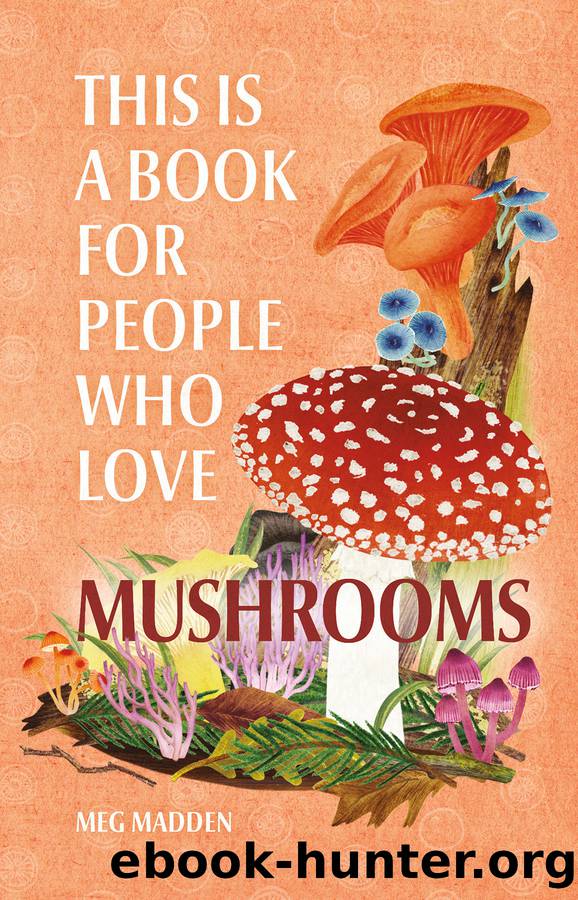This Is a Book for People Who Love Mushrooms by Meg Madden

Author:Meg Madden [Meg Madden and Hannah Bailey]
Language: eng
Format: epub
Publisher: Running Press
Published: 2023-03-07T00:00:00+00:00
GREEN ELF CUP
Chlorociboria aeruginascens and C. aeruginosa
What teeny, tiny green elf cups lack in size, they make up for with their huge wow factor. One of the prettiest and most unique mushrooms, they produce a brilliant pigment called xylindein, giving them an all-over teal-blue color not commonly found in the natural world. As the fungus grows, the mycelium often stains its substrate wood the same bright turquoise color, inspiring the common name âgreen stain fungus.â The unusually colored wood, also known as green oak, is highly prized by woodworkers for use in detailed inlays on items such as decorative boxes. The most famous example of this is Tunbridge ware style, which was popular in England during the eighteenth and nineteenth centuries. Xylindein also shows great promise as a nontoxic, eco-friendly alternative to synthetic dyes used in the textile and clothing industry.
Considered a âholy grailâ species, many mushroom hunters have spent years in search of these elusive mushrooms to no avail. Green elf cup fungi fruiting bodies are extremely smallâoften ¼â (6 mm) or less acrossâand often grow out of sight on the underside of well-rotted downed branches and logs, two factors that can make them challenging to spot. The best tactic is to keep an eye out for bright blue-green wood lying on the forest floor. The miniature cups can be easily overlooked, but with luck and a keen eye, a close inspection of the underside of the wood may reveal a colony of these striking woodland treasures.
HABITAT & ECOLOGY: Saprobic, often on the undersides of moist, well-rotted, bark-free branches and logs in mixed hardwood and coniferous forests.
DISTRIBUTION: Widely distributed.
SEASON: The blue-stained wood can be found year-round, but the fruiting bodies typically appear in late summer and fall and may occasionally overwinter.
PHYSICAL DESCRIPTION: Teal blue to blue-green cup-shaped fruiting bodies range from less than ¼" (6 mm) to, less commonly, ½" (1.25 cm) across and are attached to their wood substrate by a tiny, sometimes off-center, stem. Upper and lower surfaces are smooth and similarly colored. Though Chlorociboria aeruginascens is more common in North America than C. aeruginosa, they look practically identical to the naked eye and can be reliably distinguished only by observing their differing spore shapes under a microscope. Spore print white.
Download
This site does not store any files on its server. We only index and link to content provided by other sites. Please contact the content providers to delete copyright contents if any and email us, we'll remove relevant links or contents immediately.
| Cacti & Succulents | Flowers |
| Mushrooms | Trees |
Sapiens: A Brief History of Humankind by Yuval Noah Harari(14315)
The Tidewater Tales by John Barth(12625)
Mastermind: How to Think Like Sherlock Holmes by Maria Konnikova(7278)
Do No Harm Stories of Life, Death and Brain Surgery by Henry Marsh(6905)
The Thirst by Nesbo Jo(6877)
Why We Sleep: Unlocking the Power of Sleep and Dreams by Matthew Walker(6651)
Life 3.0: Being Human in the Age of Artificial Intelligence by Tegmark Max(5509)
Sapiens by Yuval Noah Harari(5321)
The Longevity Diet by Valter Longo(5039)
The Body: A Guide for Occupants by Bill Bryson(5027)
The Rules Do Not Apply by Ariel Levy(4908)
The Immortal Life of Henrietta Lacks by Rebecca Skloot(4548)
Animal Frequency by Melissa Alvarez(4424)
Why We Sleep by Matthew Walker(4394)
The Hacking of the American Mind by Robert H. Lustig(4336)
Yoga Anatomy by Kaminoff Leslie(4332)
All Creatures Great and Small by James Herriot(4268)
Double Down (Diary of a Wimpy Kid Book 11) by Jeff Kinney(4240)
Embedded Programming with Modern C++ Cookbook by Igor Viarheichyk(4138)
